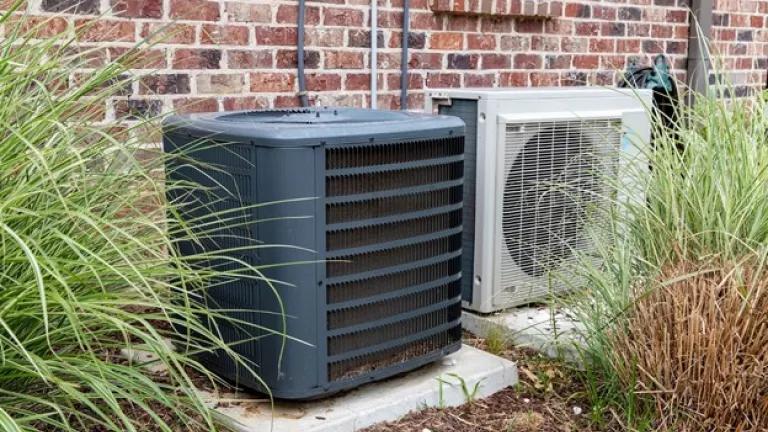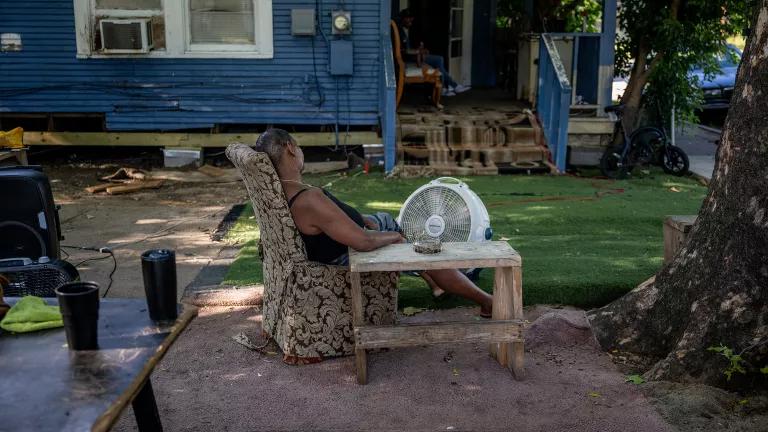New Senate Bills Encourage U.S. Heat Pump Manufacturing Jobs
Buildings are one of the largest sources of carbon pollution and figuring out how to slash those emissions is central to our efforts to address the climate crisis.

A heat pump installed as part of a mini-split heating and cooling system
Buildings are one of the largest sources of carbon pollution and figuring out how to slash those emissions is central to our efforts to address the climate crisis. But how do we go about decarbonizing our buildings? Enter: the trusty heat pump. Today’s modern heat pump is significantly more effective than the heat pumps of the 1980s or 1990s, and is a super-efficient way to heat and cool your home. Yet, we are nowhere near the level of heat pump deployment needed to electrify the existing building stock and meet our 2050 climate goals.
Two recently introduced bills in Congress would go a long way to building a robust U.S. market for heat pumps. First, a bill from Sen. Ed Markey, the “Installing Clean Efficient Energy Hastens Our Transition” or ICEE HOT Act (S. 4144), creates a rebate program for distributors of heating, ventilation, air conditioning, water heating, and other equipment used to electrify buildings. Second, the Heating Efficiency and Affordability through Tax Relief Act,” or HEATR Act (S. 4139), from Sen. Amy Klobuchar would provide tax incentives for manufacturers to make heat pumps for both space and water heating. The HEATR Act builds on a concept NRDC and allies began pushing in 2021, to update section 45M of the tax code to accelerate market adoption of heat pump technology.
“Upstream” incentives like these given to manufacturers, distributors, or retailers results in lower prices at the time of sale, rather than at the time of filing taxes. It’s also a more equitable way to incentivize this equipment, because lower-income households may be unable to afford a higher upfront cost. Plus, these bills encourage U.S. manufacturing and the high-quality jobs that go along with that.
While the two bills above focus on upstream incentives, other heat pump incentives have been included in recent legislative proposals, such as the Energy Security and Independence Act of 2022 from Sen. Bernie Sanders and Rep. Cori Bush (S. 4013, and H.R. 7439), which would fund a heat pump deployment program at DOE. Another recent proposal relies on rebates to homeowners for choosing energy efficient products, such as Home Energy Savings Act from Sen. Maggie Hassan and Rep. Aisha Gomez (S. 1753 and H.R.3395), Sen. Ron Wyden’s Clean Energy for America Act (S. 2118), and Sen. Angus King’s Air Source Heat Pump Act of 2021 (S.891).
In spite of the many climate and energy benefits of heat pumps, myths still exist about their performance, and about building electrification in general. The incentives proposed by Congress are important to develop the market and get contractors more familiar with heat pumps. There’s a revolution underway in heat pump technology, but the conversation about them is often stuck in the past. Consider these key facts:
- Today’s heat pumps work in the very cold. Some 1980s products didn’t work out so well (New Coke, anyone?). Just like we’ve put away our jazzercise legwarmers in favor of heart monitors to help stay fit, today’s heat pumps have come a long way. They get tested for very high efficiencies down to 5°F (not just in mild temps anymore), and can find heat even in negative ambient air temperatures! Take a look at the Cold Climate Air Source Heat Pump product list from Northeast Energy Efficiency Partnerships; you’ll find more than a few heat pumps rated to serve an average size home at single digit temperatures. In fact, heat pumps have become wildly popular in places like Maine and Minnesota, where they comfortably heat homes while saving consumers money on their heating bills, particularly when replacing oil or propane heating systems.
- Comfort levels meet or exceed expectations. A new high-efficiency, variable-speed heat pump can dehumidify your house better than a traditional central air conditioning system, a big factor in warm weather comfort. In fact, the same variable speed fan motors and compressors that save energy and help with humidity also help with other aspects of comfort, including alleviating temperature swings and filtering. As temperatures warm across the country, more residents will find themselves needing air conditioning. A heat pump provides both heating and cooling. It is often a more comfortable and a more economical choice than installing a standalone air conditioner. Plus, they have back-up resistance elements that maintain full comfort even on the coldest polar vortex days.
- Heat pumps emit a lot less carbon than even the most efficient gas furnaces. A recent study by UC Davis quantified the carbon impacts of heat pumps over the next 15 years, finding that a typical U.S. home can cut its heating-related climate pollution by 45 percent to 72 percent over a gas furnace. And using NREL’s Cambium dataset, the study showed that heat pumps save carbon in every region of the country as the grid continues to get cleaner.
- Heat pumps can save you money. Ben Lipscomb of the National Comfort Institute captured it well, “Compared to electric resistance, fuel oil, and propane, heat pumps do save money pretty much everywhere.” In some parts of the country, methane gas is really cheap, in part because gas prices don’t pay for cleaning up gas pollution. But as we begin to account for externalities and global price volatility, the smart money is on heat pumps.
- Heat pumps work in most building types. Heat pumps and heat pump water heaters work in commercial, residential, and multifamily buildings, as well as in buildings of all ages and configurations. Washington State recently updated its building code to require heat pumps for space and water heating in most new multifamily and commercial buildings. Heat pumps come in a variety of configurations, including ducted and ductless models, which can also make retrofitting older buildings more straightforward. There’s a heat pump for everyone.
These smart tax credit proposals will support the transition to heat pumps, which will reduce energy costs for American households – and the carbon impact of staying warm in winter and cool in the summer. Heat pumps can also help avoid sticker shock associated with fluctuations in global oil and gas markets, making it easier for families to plan their expenses. By supporting the domestic supply chain for heat pumps, these proposals ultimately help residents make the switch to efficient electric equipment.



